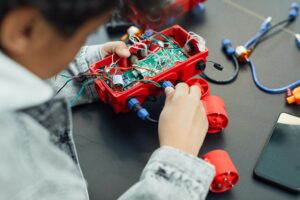Automated Machine Learning (AutoML): Revolutionizing the Future of AI Development
Introduction
In the past decade, machine learning (ML) has evolved from a niche research topic to a critical driver of innovation across industries. From personalized product recommendations to fraud detection, from healthcare diagnostics to self-driving cars, machine learning models are now at the heart of modern technological advancement. However, despite its immense potential, developing effective ML models remains a complex, time-consuming, and resource-intensive process.
This is where Automated Machine Learning (AutoML) steps in. AutoML simplifies and automates the end-to-end machine learning pipeline, making it accessible not only to data scientists but also to domain experts and business professionals with little or no background in coding or statistics.
In this comprehensive article, we will explore what AutoML is, how it works, its components, applications, benefits, limitations, and future potential.
What is Automated Machine Learning (AutoML)?
Automated Machine Learning (AutoML) refers to the process of automating the development, training, tuning, and deployment of machine learning models. Instead of manually selecting algorithms, preprocessing data, tuning hyperparameters, and evaluating performance, AutoML systems streamline these steps using advanced techniques such as meta-learning, reinforcement learning, and neural architecture search.
At its core, AutoML aims to democratize AI by lowering the barriers to entry. It enables non-experts to build competitive models while also helping experienced data scientists accelerate their workflows.
The Need for AutoML
Traditional machine learning development is a complex cycle that involves:
-
Data preprocessing – cleaning, normalizing, and encoding raw data.
-
Feature engineering – creating meaningful features that capture hidden patterns.
-
Algorithm selection – choosing the right ML model for the task.
-
Hyperparameter tuning – adjusting parameters to improve performance.
-
Model evaluation – assessing performance using appropriate metrics.
-
Deployment and monitoring – integrating models into production environments.
Each of these steps requires expertise and significant trial-and-error. For organizations with limited ML talent, this creates bottlenecks. Moreover, even skilled data scientists spend a large portion of their time on repetitive tasks instead of high-level innovation.
AutoML addresses these challenges by automating large portions of the pipeline, saving time, reducing human error, and enabling broader adoption of machine learning.
How Does AutoML Work? (The AutoML Pipeline)
AutoML systems vary in design, but most follow a general pipeline that includes several automated steps:
1. Data Preprocessing
-
Handling missing values.
-
Scaling and normalization.
-
Encoding categorical variables.
-
Detecting and removing outliers.
2. Feature Engineering
-
Automatically generating new features.
-
Selecting the most relevant features using statistical and ML-based methods.
-
Reducing dimensionality with PCA or embeddings.
3. Model Selection
-
Exploring multiple algorithms (e.g., decision trees, gradient boosting, neural networks).
-
Comparing their performance using cross-validation.
4. Hyperparameter Optimization
-
Using techniques like Bayesian optimization, random search, or genetic algorithms to fine-tune models.
5. Ensembling
-
Combining multiple models (stacking, bagging, boosting) to improve predictive performance.
6. Model Evaluation
-
Selecting the best model based on metrics such as accuracy, F1-score, precision, recall, ROC-AUC, or RMSE.
7. Deployment and Monitoring
-
Exporting models for production use.
-
Monitoring model drift and performance degradation over time.
Key Techniques Behind AutoML
-
Bayesian Optimization – Finds optimal hyperparameters efficiently by building probabilistic models of the search space.
-
Neural Architecture Search (NAS) – Automates the design of deep neural network architectures.
-
Meta-Learning – Uses past ML experiments to guide future model selection.
-
Reinforcement Learning – Helps systems learn the best strategies for tuning and optimization.
-
Ensemble Learning – Combines multiple weak learners into strong predictive models.
Benefits of AutoML
-
Accessibility – Makes machine learning available to non-experts.
-
Time Efficiency – Reduces model development from weeks to hours.
-
Cost Savings – Lowers the need for large ML teams.
-
Consistency – Minimizes human bias and errors in model selection.
-
Scalability – Enables organizations to experiment with more models at scale.
-
Productivity – Allows data scientists to focus on high-level strategy and innovation.
Challenges and Limitations of AutoML
While AutoML is transformative, it is not without challenges:
-
Interpretability – Automated models can act as “black boxes,” making it difficult to explain decisions.
-
Computational Costs – Running multiple models and hyperparameter searches requires high computing power.
-
Data Quality Dependence – AutoML cannot fully compensate for poor-quality or biased data.
-
Overfitting Risks – Automated pipelines may overfit if not carefully monitored.
-
Customization Limitations – Domain-specific expertise may still outperform fully automated systems in niche problems.
Popular AutoML Tools and Frameworks
Several open-source and commercial AutoML platforms are widely used today:
Open-Source Tools
-
Auto-sklearn – Extends scikit-learn with automated model selection and hyperparameter tuning.
-
TPOT (Tree-based Pipeline Optimization Tool) – Uses genetic programming for pipeline optimization.
-
H2O AutoML – Provides distributed, scalable AutoML for large datasets.
-
MLJar – Easy-to-use tool for beginners, focused on explainability.
-
AutoKeras – Specialized in automated deep learning and NAS.
Commercial Platforms
-
Google Cloud AutoML – Provides domain-specific AutoML (vision, NLP, translation).
-
Microsoft Azure AutoML – Integrated with Azure ML services for enterprise workflows.
-
Amazon SageMaker Autopilot – End-to-end AutoML on AWS.
-
DataRobot – Popular enterprise-grade AutoML solution.
-
RapidMiner Auto Model – Simplifies model creation for business analysts.
Applications of AutoML Across Industries
AutoML has widespread adoption across multiple sectors:
1. Healthcare
-
Disease prediction and diagnostics.
-
Drug discovery.
-
Personalized treatment recommendations.
2. Finance
-
Fraud detection.
-
Credit scoring.
-
Algorithmic trading.
3. Retail & eCommerce
-
Personalized product recommendations.
-
Customer segmentation.
-
Demand forecasting.
4. Manufacturing
-
Predictive maintenance.
-
Supply chain optimization.
-
Quality assurance through anomaly detection.
5. Marketing
-
Customer churn prediction.
-
Campaign optimization.
-
Sentiment analysis.
6. Transportation
-
Route optimization.
-
Self-driving vehicle perception.
-
Fleet management.
7. Cybersecurity
-
Intrusion detection.
-
Malware classification.
-
Threat intelligence automation.
The Future of AutoML
The trajectory of AutoML points towards even greater adoption and innovation. Future trends include:
-
Integration with Low-Code/No-Code Platforms – Making ML accessible to business users.
-
Explainable AutoML (XAutoML) – Ensuring transparency and interpretability in automated models.
-
Federated AutoML – Combining AutoML with privacy-preserving techniques for distributed data.
-
Edge AutoML – Enabling ML automation on IoT and edge devices.
-
Hybrid AutoML + Human Expertise – Blending automation with domain knowledge for optimal results.
-
Real-Time AutoML – Building models that adapt instantly to new data streams.
Ethical Considerations in AutoML
As AutoML expands, ethical challenges must be addressed:
-
Bias in Data – Automated systems can amplify existing societal biases.
-
Job Displacement – Reduced demand for manual ML tasks could impact employment.
-
Decision Accountability – Who is responsible if an AutoML system makes a harmful decision?
-
Privacy Concerns – Ensuring secure handling of sensitive data.
Case Studies
1. Google Cloud AutoML in Healthcare
A leading hospital used Google AutoML Vision to classify medical images for early detection of lung diseases. The automated models outperformed baseline approaches and reduced diagnostic turnaround time.
2. DataRobot in Finance
A financial institution applied DataRobot AutoML for fraud detection. By automating model development, the team reduced fraud losses by 30% while cutting model training time in half.
3. H2O AutoML in Retail
A global retail company used H2O AutoML to predict product demand across regions. The system generated highly accurate forecasts, optimizing inventory and reducing waste.
Final Thoughts
Automated Machine Learning (AutoML) is not just a technological trend—it is a paradigm shift in how we approach artificial intelligence. By automating tedious and complex parts of the ML pipeline, AutoML empowers organizations to scale AI initiatives faster, democratizes access to machine learning, and frees up experts to focus on innovation.
While challenges around interpretability, computational resources, and ethics remain, the benefits of AutoML are undeniable. As the technology matures, it will become a cornerstone of AI adoption across industries, shaping a future where creating powerful ML models is as easy as pressing a button.
Vision-Based Robot Control: The Future of Intelligent Robotics






